With its 2.5-litre, five-pot engine, the Ford Focus ST Mk2 is one of the most tunable Fast Fords around, here’s our complete tuning guide to help you modify your ST225.
If there’s one car that epitomises the modern fast Ford tuning scene, it’s a bright orange Ford Focus ST Mk2. When it arrived in 2005, the ST225 (as it soon became dubbed thanks to its 225PS/222bhp turbocharged engine) brought some much-needed performance credentials to the second-generation Focus. Its playfulness, endless grunt, and the sheer fun factor of driving one secured its immediate hit status.
It wasn’t just a hit with buyers either, but with the modifying scene too, which soon realized that the Volvo-sourced five-cylinder could dish out much more than factory 222bhp. That coincided with the arrival of OBD-port tuning, allowing owners to remap the car from the comfort of their own driveway, and on the Ford Focus ST Mk2 it yielded particularly impressive results of 40-to-50bhp gains.
This was coupled with the fact that many tuners had already seen great success with the same engine in fast Volvos, and it didn’t take long before UK companies seized on the information available and were able to offer significant power upgrades, almost overnight. Something of a performance tuning arms race began at once; tuners and specialists all had STs on their fleets of demo cars, and new performance tuning products came to the market seemingly every week.
Available mods over time
At first, simple bolt-on mods gave the factory power a boost to around 300bhp, but it wasn’t long before full builds and bigger turbos were emerging.
Then, Ford Focus ST Mk2 tuning took another leap forward in 2009 when the RS model arrived. Based on the same second-generation Focus platform as the ST, the RS offered factory-fit upgrades that delivered over 300bhp, with the potential for more. So much more.
Today, tuners and owners are continuing to develop performance upgrades, and there’s an abundance of interior and exterior styling options to make your ST truly unique.
There’s a reason the Focus ST225 is still so popular in the fast Ford scene; little else offers anywhere near the driver satisfaction and immense tuning potential. And, with prices at an all-time low, now is the time to buy, tune, and, most importantly, enjoy one of the greatest fast Fords ever built.
Here’s our tips on how to make one of the very best even better.
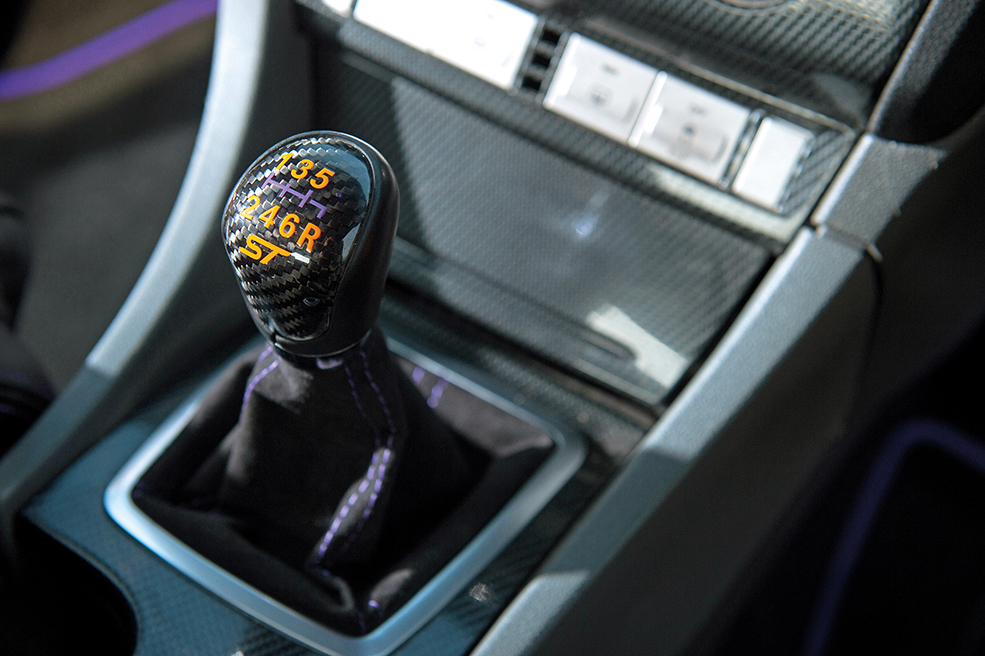
Transmission upgrades
The Ford Focus ST Mk2 came with the ultra-tough Getrag M66 six-speed gearbox; it’s the same unit shared with the RS and we all know how much power they can take without fuss. Therefore, providing it’s all in good health, there’s not much you need to concern yourself with for most applications.
Clutch & Flywheel
You will, though, need to look at clutch upgrades for anything other than a first-stage remap. Thankfully the RS’s clutch and flywheel assembly is a direct, factory upgrade and is more than enough for most road-going STs, capable of holding 400-to-450bhp without too many dramas.
But genuine RS parts aren’t cheap, and for similar money you could also get various upgrades, ranging from beefier organic clutches, through to various paddle clutch designs, or even twin-plate setups. Speak to your tuner to discuss which is the best option for your intended use.
The original rubber lower torque mount will be perished and split by now, so a stiffer polyurethane upgrade is a no-brainer. Many ST owners also like to fit a short-shift kit, with a current trend towards fitting entire shifter towers from the likes of CAE, which also have a visual impact on the interior as well as a positive shifter action.
Limited Slip Differentials
One thing the ST’s M66 does lack is the factory-fitted Quaife ATB ($829/£808) found in the RS, so a proper limited-slip diff upgrade is a worthwhile investment – especially for big-power cars or those driven hard regularly on track.
Of course, the Quaife offers an OEM-style upgrade, but there are plenty of fit-and-forget solutions such as similar torque-biasing solutions from Wavetrac ($1427/£1392), Blackline and M Factory. These are ideal for most fast-road and occasional track day cars, but if you’re looking from something a bit more track-focused then a plated-type diff from Gripper or 3J Driveline might be up your street. Plated diffs are generally considered a bit harsh for regular road use, but are well suited to hard track abuse.
Speaking of which, if you want the ultimate in ST transmissions then look at the Quaife QKE45Z sequential gearbox. It’s not cheap (prices start at $6500/£5750, but rapidly increase when you add extras such as super-finished gears, gear indicator displays, and oil breathers) but it is a direct replacement for the M66 and will transform the way you drive the car, regardless of the power it has.
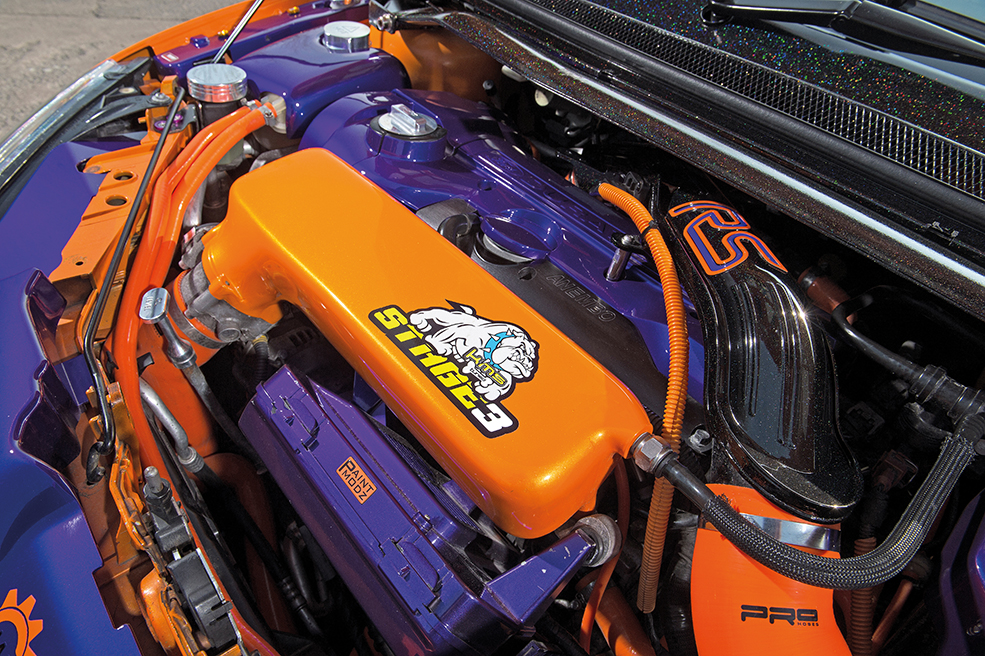
Ford Focus ST Mk2 Engine Tuning
The growling turbocharged five-pot found in the Mk2 ST has become the signature soundtrack for a generation of fast Fords. While the same basic layout has been proven to produce very big numbers (over 1000bhp has been achieved on numerous occasions), the stock ST engine does need some TLC to get the best out of it.
Engine Strengthening
If you’re planning on any future performance engine tuning, or just to drive your ST with some spirit, then one of the first modifications you should be looking at is the fabled block mod. The aluminum block has steel liners, which have been well documented for cracking or splitting – even at factory levels of tune. The cure for a cracked liner is a new block (and you might as well go for an RS block if that happens), but if yours is in good health the much talked-about block mod is a great preventative measure.
It was all top-secret stuff at the time, but the block mod is effectively nothing more than a series of precise shims inserted in between the cylinders to prevent any unwanted movement causing the liners to crack. There are plenty of tuners offering the block mod, so it’s something that should be high on your list of priorities if you plan any further tuning, or purely for peace of mind.
ECU Remap & Supporting Mods
That said, generally speaking the first stages of tune should be okay on a stock block. A first-level software upgrade will take power to around 260bhp, and thanks to the ST’s OBD port you can upload a remap from the comfort of your own driveway.
Add some hardware upgrades to improve the breathing restrictions of the standard car (air filter, intercooler, exhaust) and 300bhp is easily within reach. You’ll want an uprated breather (the stock breather is prone to problems anyway) and will also need to relocate the ECU if you’re fitting an induction kit.
Beyond this, you really need the aforementioned block mod, or you’re asking for trouble.
Focus RS Parts
Now you’re knocking on the door of RS power levels, and the next step up involves robbing big brother of some of its components – a cost-effective way of upgrading if you can find an RS owner who has just upgraded themselves and has second-hand RS components for sale.
A set of bigger RS injectors and a stronger actuator on the turbo will yield around 340bhp, which is getting close to the limits of the stock ST rods and pistons. RS internals will safely see you into the 400s, and you’ll need the RS’s BorgWarner turbo to get you there too.
Most people consider around 420bhp as the limit for OE RS stuff, after which point you’ll end up on the same upgrade path as for the legit RS models. This includes fully forged rods and pistons, lairy cams, bigger valves, ported cylinder head, larger injectors and an even bigger turbo – all of which will see you well into the 500bhp range.
Engine Management/ECU
But it doesn’t stop there these days. One of the biggest leaps forward in ST tuning was the introduction of plug-and-play engine management systems. These allow tuners to remove the potentially troublesome MAF sensor and replace it with a MAP sensor instead, which is better suited to high-boost, big-power engines.
Modern aftermarket ECUs also allow tuners to take full advantage of tricks such as flex-fuel (various different ethanol/methanol fuel blends), clever torque limiting strategies (that means big-power 700-to-1000bhp cars can still put the power down effectively), and all manner of modern electronic trickery that helps the engine produce power reliably and controllably. It really is a case of how far do you want to go?
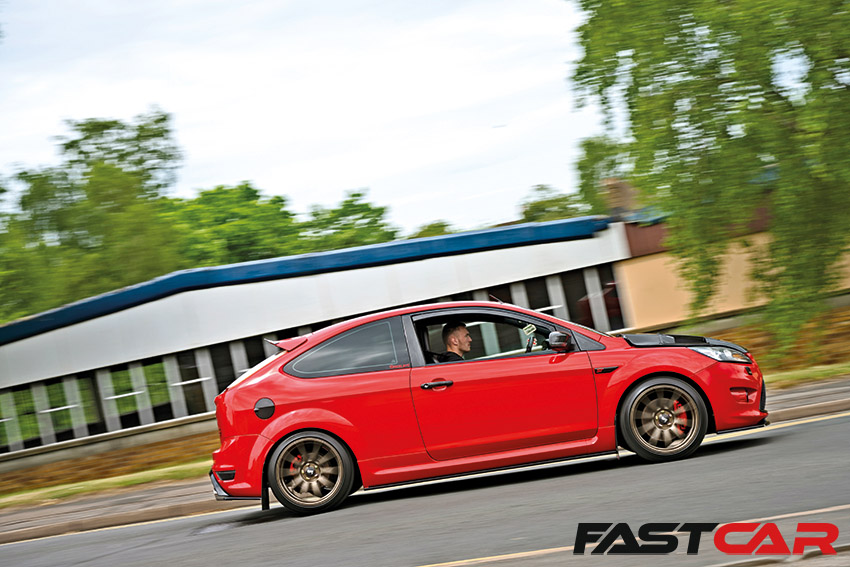
Ford Focus ST Mk2 Suspension Tuning
The first thing you need to ask yourself when it comes to suspension, is ‘what do I want from the car?’, as your answer will influence your choices.
Is it all about the lows at shows? Then a custom air-ride kit is probably the way to go to achieve a show-stopping stance but still remain useable on the road.
Lowering Springs & Dampers
For most, though, the first step to improving the ST’s suspension is a basic set of lowering springs, which you can source for less than a couple of hundred quid – even for top-quality parts.
Even better is to couple the lowering springs with a set of matched dampers. Something like Bilstein’s B12 kit ($721/£704) is perfect for a road-going ST, improving handling, roadholding and ride height all without sacrificing ride comfort for daily use – it’s a factory-quality, fit-and-forget upgrade.
Coilovers
Of course, you might not want to forget, and if you like the odd track day or two you might want the ability to tinker with the settings to find the perfect balance to suit your car and driving style.
In that case, a set of coilovers is probably the answer. Coilovers range from budget options at about $/£500 right through to race-spec three-way adjustable units at over $/£5000. Most ST owners won’t be looking at either extreme; instead, quality kits like KW’s Variant 3s ($2205/£2152) and Bilstein’s B16 ($1588/£1550) will give the perfect mix of on-track performance but without rendering the car unbearable for regular road use, to hit that sweet-spot between road and track. Going much lower than a 25mm drop should be accompanied by adjustable top mounts to dial out excessive negative camber.
Peripheral Suspension/Chassis Mods
The Ford Focus ST Mk2 also responds well to a set of uprated anti-roll bars. Many are adjustable with different mounting points for drop-links altering the effective stiffness of the bar; start at the softest setting and work up from there.
Finally, a full set of poly bushes for the ST will cost around $/£600, and make a notable improvement on road and track cars alike. The beauty with these is that you can do them one pair at a time when funds allow, and they also replace worn-out rubber bushes with something that gives genuine performance benefits and will never wear out again, It’s a no-brainer when your standard bushes inevitably fall apart.
The ST tends to suffer badly on the front wishbones, which take massive stress during gearchanges. The stock bushes are oil-filled and prone to splitting from as low as 12,000 miles, so even if the rest of your ST is completely standard, you should still look to fit a set of polyurethane bushes in the front wishbones.
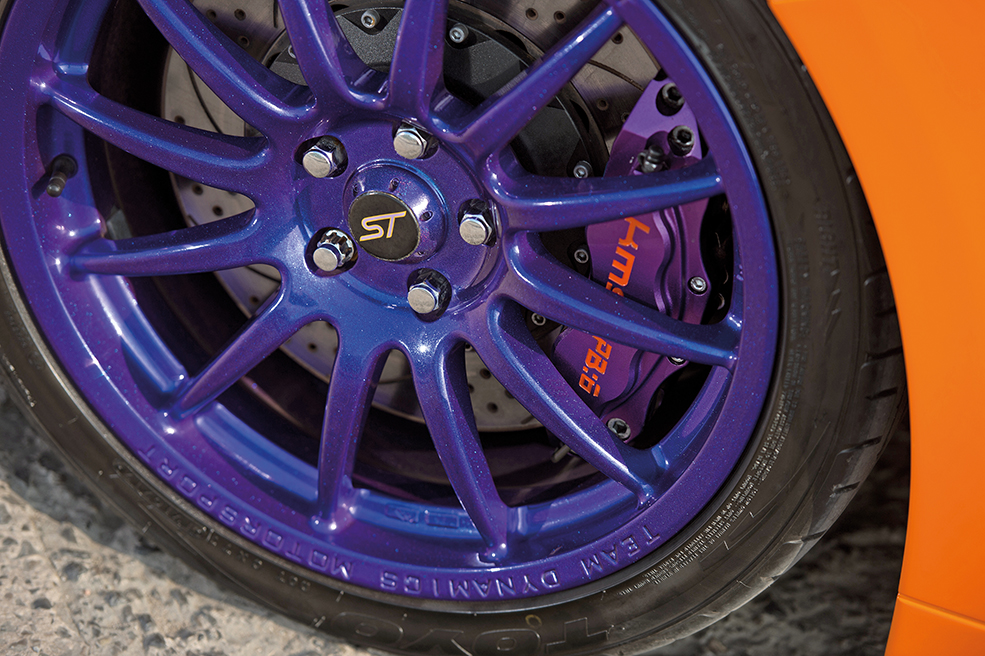
Ford Focus ST Mk2 Brake Tuning
The ST has 320mm discs at the front as standard, which are pretty big for a road car. A decent set of pads is the first step at around $/£150-250, and when coupled to performance discs, decent fluid and braided lines, provide enough stopping power for most road-going STs.
Of course, for track cars and those looking for the pose-factor, there are plenty of big brake kits available from the likes of AP Racing, PB Brakes, Tarox and K-Sport; Collins Performance even offers a kit using the Brembos from the Mk3 Focus RS as a cheaper alternative.
Prices range from about $/£1200-$/£3000 depending on exact spec.
Wheels & Tires
The stock ST alloys are heavy, and people have fitted them to everything from Mondeos to Transit Connects. Ditch them in favor of some lightweight motorsport rims for a reduction in unsprung weight, better brake cooling, and better style too.
Stock sizes are 8x18in with a high offset of ET52.5, but there’s room to reduce this to around ET40. Even an increase to 8.5in width will fit with an ET40-42 offset without causing any issues. Of course, if you’ve fitted one of the wide-arch kits available for the ST, you can go even wider and more aggressive on the offset.
As for tires, fit cheap and nasty rubber at your peril. Why undo all that hard work with chassis and performance tuning by fitting a cheap set of boots? Stick on some quality treads from a reputable brand and enjoy your ST’s full potential.
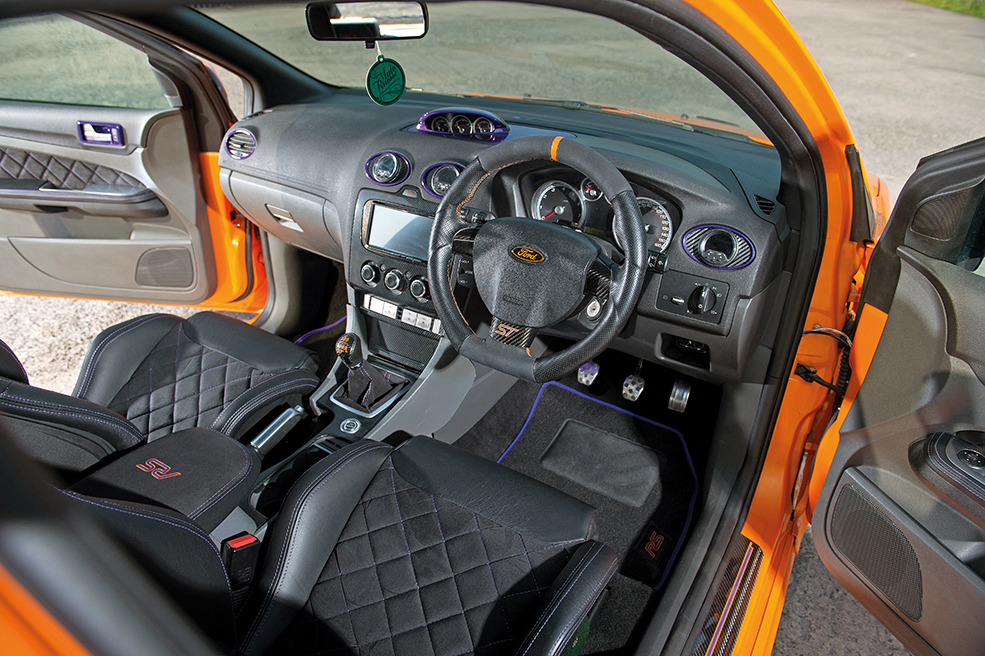
Interior Modifications
The ST came with cloth or leather Recaros depending on spec, and while there’s nothing wrong with them at all, they simply aren’t as nice as the Sportster CS shell seats found in the later RS. You can make these fit an ST with relative ease, and they improve the look and feel of the cabin no end – plus offer a more supportive driving position for any track or spirited fast-road driving.
Some owners like to remove the rear seats, and often add a roll cage (either a real one or a cage just for show) for that clubsport vibe.

Exterior
The ST looks good in standard trim (many owners like to keep things just as the factory intended), but subtle additions like splitters, lowline kits, bonnet vents and spoiler extensions give a stealthy hint of aggression while in keeping with the OEM-plus vibe.
But go to any Ford show during the summer and you’ll notice that the ST is merely a blank canvass for you to express your personality, and you can go as crazy as you like; wide arch kits and WRC-inspired wings and bumpers are all readily available to give the Focus an adrenaline shot, while many owners tend to top these off with custom wraps to really stand out from the crowd.
Photos: Ade Brannan.
The post Ford Focus ST Mk2 Tuning Guide appeared first on Fast Car.
Leia Mais.